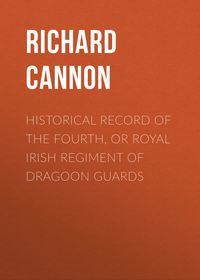 полная версия
полная версияHistorical Record of the First Regiment of Foot
In the meantime the second battalion had marched from Scotland to York. In August it proceeded to Hertford and Ware; and in September to Gravesend, where the first battalion had previously arrived from Hounslow Heath; and the two battalions being again united, occupied Gravesend, Tilbury-Fort, Sheerness, and other places along the banks of the Thames and the coast of Kent.
At this period the nation was violently agitated by political events. The King, being a roman catholic, and being guided by jesuitical councils, and countenanced and encouraged by a few families of the same persuasion, was attempting to effect the subversion of the established religion and laws. At the same time many noblemen and gentlemen who felt the greatest concern for the welfare of their country had invited the Prince of Orange to come to England with a Dutch army to aid them in resisting the proceedings of the court. Thus the kingdom was divided against itself, and men were looking forward, with a mixed feeling of hope, terror, and consternation, to the great convulsion which threatened the State. The King made preparations to avert the danger, and augmented his army, when the Royal Regiment was increased to 26 companies, and the total strength to 1858 officers and soldiers, each battalion having now a grenadier company.
In the early part of November, the Dutch fleet having sailed past Dover, the Royal Regiment was ordered to the west; and when the Prince of Orange had landed at Torbay and advanced to Exeter, it proceeded to Warminster, which was the most advanced post of the royal army. The head-quarters were at Salisbury, and King James reviewed his army on Salisbury Plain on the 21st of November. But his Majesty found that his conduct had alienated the affections not only of his subjects in general, but of the officers and soldiers of his army, many of whom forsook his camp and joined the Prince of Orange. Yet, while many of the nobility and gentry, with officers and soldiers from almost every regiment in the army, were quitting the King's standard daily, the Royal Regiment of Foot was an exception; it preserved its ranks entire, and stood with an unshaken loyalty amidst the general defection which prevailed in the kingdom.
When the King ordered his forces to retire towards London, the Royal Regiment marched, first to Devizes, and afterwards to Windsor, where it arrived on the 29th of November. The desertions continuing, the King sent orders to Lieut. – General the Earl of Feversham to make no further resistance to the Prince of Orange, and his Majesty afterwards attempted to effect his escape to France. These orders produced much confusion. Several corps were disbanded; and the men spreading themselves in parties over the country, committed many disorders. The Royal Regiment, however, appears to have been equally conspicuous for good order as for loyalty, and continued at its post of duty until directed by the Prince of Orange to march to Oxford.
Although the King failed in his first attempt to escape to France, yet he afterwards succeeded, and having been followed by the Earl of Dumbarton, the Colonel of the Royal Regiment, the Prince of Orange conferred the Colonelcy on one of his most distinguished officers, Marshal Frederick De Schomberg, afterwards Duke Schomberg.
1689After these events had transpired, a convention was assembled, which declared the throne abdicated and vacant, and conferred the sovereignty on William and Mary, Prince and Princess of Orange. Many of the officers and men of the Royal Regiment were, however, not satisfied with the new arrangements. Their regiment had been King James's favourite corps, on account of its antiquity, valour, and good conduct, and its having served with his Majesty in France, when he was an exile. Having preserved their loyalty to the last, the officers and men did not expect much favour from the new king. At the same time they were not pleased that a foreigner, Marshal Schomberg, though an officer of distinguished merit, should be placed at the head of a national Scots corps. While these feelings were prevalent in the breasts of the officers and men, the regiment received orders to embark for the Netherlands to replace the Dutch troops which were in England. This order was considered premature: the national assembly in Scotland had not declared for King William, and the Scots officers and soldiers did not consider themselves bound to obey the commands of a king who had not been acknowledged in Scotland. Under this impression a number of officers and men mutinied, and, seizing the money appointed for their pay, marched with four pieces of cannon towards Scotland. At the same time the Royal Regiment of Scots Horse, commanded by Major-General Viscount Dundee, deserted from its quarters at Abingdon, and proceeded in the same direction.69 The King sent Major-General Sir John Lanier with his own (now the First Dragoon Guards), and Colonel Langston's regiment of horse, and Lieut. – General De Ginkell (afterwards Earl of Athlone) with three regiments of Dutch dragoons, in pursuit of the mutineers; and these troops having overtaken the men of the Royal Regiment in Lincolnshire, about twenty officers and five hundred men, who had previously become convinced of their error, laid down their arms and submitted themselves to the King's clemency. King William III. is reported to have repeatedly expressed his admiration of the firm loyalty and attachment evinced by the officers and soldiers of the Royal Regiment to their former sovereign, when he was forsaken by almost every other person; and the King, after dismissing three or four officers, pardoned the remainder of the regiment, and ordered the first battalion to be completed to its establishment from the second, and to proceed to its original destination.
The second battalion of the Royal Regiment having transferred its serviceable men to the first, proceeded to Scotland; and the first battalion embarked for the Netherlands, where it arrived in the beginning of May, 1689, and joined the Dutch camp at Tongres in the early part of June. The British troops were commanded by the Earl of Marlborough,70 and the combined army by Prince Waldeck. The Royals were employed in several operations; and on the 25th of August they took part in a sharp action with the French troops commanded by Marshal d'Humieres, at Walcourt, in the province of Namur. The enemy attacked a foraging-party, and this brought on a sharp action, in which the British infantry evinced firmness and intrepidity, particularly a detachment under Colonel Robert Hodges;71 and the French were repulsed with considerable loss.
1690During the winter, the second battalion of the Royal
Regiment, having recruited its ranks, was sent from Scotland to Holland; and in the summer of 1690 both battalions took the field. On the 21st of June, the regiment was on its march to Brussels; but Prince Waldeck, without waiting for the arrival of the British troops, engaged the French at Fleurus, and was defeated. This disaster reduced the combined army to the necessity of limiting its operations, and acting on the defensive during the remainder of the campaign.
1691On the 1st of July, 1690, Marshal Duke Schomberg was killed at the battle of the Boyne in Ireland; and the Colonelcy of the Royal Regiment remained vacant until the 5th of March, 1691, when it was conferred by King William III. on Lieut. – Colonel Sir Robert Douglas.
The regiment having been withdrawn from its winter quarters in the month of March, 1691, was encamped at Halle, in South Brabant, where the first battalion was formed in brigade with the Scots Foot Guards, and the regiments of Ramsay, Angus, Mackay, and Hodges; and the second battalion was posted, with O'Ffarrel's regiment, between two divisions of Dutch infantry.72 The French besieged Mons, and the confederates being unable to relieve the place, the garrison surrendered on the 31st of March, when the French troops went into quarters.
After the surrender of Mons, the Royal Regiment was sent into garrison, from whence it was withdrawn in May, and was encamped near Brussels, and both battalions were formed in one brigade with the Scots regiments of Mackay, Ramsay, O'Ffarrel, and Angus, under the orders of Brigadier-General Ramsay. The summer was passed by the opposing armies in manœuvring on the rich plains of the Netherlands; and in October the troops marched into quarters for the winter.
1692In the spring of 1692, Louis XIV. marched into the Netherlands with an immense army and besieged Namur, when the Royal Regiment was called from its cantonments, and advanced with the army, commanded by King William III. in person, to the relief of the place; but the march having been delayed by heavy rains, the garrison surrendered on the 20th of June. On the 23rd of that month, Colonel Sir Robert Douglas, with 2 captains, 2 lieutenants, 2 ensigns, and 120 private men, of the Royal Regiment, was detached, with other troops, to attempt the surprise of Mons. After marching all night, the detachment arrived about one o'clock on the following morning within a short distance of the town, when the troops were ordered to halt, and Sir Robert Douglas and Colonel O'Ffarrel, having proceeded to consult with the Prince of Wirtemberg, who commanded the party, mistook their way in the dark, and fell into the hands of a detachment of French cavalry, and were made prisoners. The enemy being found prepared to resist, the detachment returned to the camp at Mellé, and Sir Robert Douglas was released on payment of the regulated ransom, and rejoined the regiment on the 29th of June.
After several changes of position, King William resolved to attack the French army commanded by Marshal Luxembourg, at its camp, near Steenkirk. On the evening of the 23rd of July (O.S.), the first battalion of the Royal Regiment, commanded by Sir Robert Douglas, the second battalion of the 1st Foot Guards, with the regiments of Fitzpatrick and O'Ffarrel, and two battalions of Danes, were ordered forward to commence the attack on the French army, and were accompanied by a detachment from each battalion of Brigadier-General Churchill's brigade, with hatchets and spades to make a passage through the woody grounds between the two armies. Between ten and eleven o'clock on the following morning these troops arrived in front of the French camp, and took post in a thick wood, beyond which there was a small valley intersected with hedges lined with French infantry, and on the opposite side of the valley appeared the French camp. About eleven o'clock two batteries opened their fire upon the enemy; and when the main body of the army had arrived within a mile of the wood, the leading regiments issued from amongst the trees and commenced the attack. "Certainly never was a more dreadful and at the same time bolder firing heard, which for the space of two hours seemed to be a continued thunder. Our van-guard behaved in this engagement to such wonder and admiration, that though they received the charge of several battalions of the enemy, one after another, yet they made them retreat almost to their very camp."73 Amongst the foremost in this action was seen the brave Sir Robert Douglas at the head of the first battalion of the Royal Regiment, emulating the noblest actions recorded in the annals of war. Having led his battalion against the troops behind the first hedge, he soon cleared it of French combatants, and drove one of the enemy's battalions from the field in confusion. A second hedge was attacked and carried by the gallant Scots in a few moments: – a third was assaulted, – the French stood their ground, – the combatants fought muzzle to muzzle, – and again the Royals proved victorious, and the third hedge was won. The toil of conflict did not cool the ardour of the veteran Scots; but forward they rushed with a loud huzza, and attacked the troops which lined the fourth hedge. Here the fighting was severe; but eventually the Royals overthrew a fourth French battalion, and drove a crowd of combatants from their cannon.74 In this conflict the first battalion lost one of its three colours. Sir Robert Douglas, seeing the colour on the other side of the hedge, leaped through a gap, slew the French officer who bore the colour, and cast it over the hedge to his own men; but this act of gallantry cost him his life, a French marksman having shot him dead on the spot while in the act of repassing the hedge. "Thus the Scots commander improved upon the Roman general; for the brave Posthumius cast his standard in the middle of the enemy for his soldiers to retrieve; but Douglas retrieved his from the middle of the enemy, without any assistance, and cast it back to his soldiers to retain."75 While the leading regiments were thus carrying all before them, the main body of the army was a mile in the rear, and could not be brought up in time to sustain the corps in advance: the Royals and other regiments of the advance-guard, after displaying a degree of constancy and valour seldom equalled, were forced to retire; and eventually the army retreated to its camp.
The loss of the regiment in this action has not been ascertained. Mention has, however, been made in history of two Captains, viz. Mackraken and Levingston, of the Royal Regiment, who were killed; and from the returns published at the time, the brigade to which the regiment belonged lost 6 field officers, 14 captains, 24 subalterns, and 507 men killed; and 6 field officers, 20 captains, 32 subalterns, and 608 men wounded76; and doubtless a number of these belonged to the Royal Regiment.
A few days after the battle, King William conferred the Colonelcy on Lord George Hamilton (afterwards Earl of Orkney) from the Royal Regiment of Fusiliers.
On the 2nd of August, a detachment of the Royal Regiment, commanded by Captain Rowland Mackenzie, was engaged with a party of French troopers in a wood near the camp, and took twenty prisoners.77 Towards the end of September the regiment marched from the camp to Bruges, from whence parties were detached to Scotland to procure recruits.
1693Having passed the winter at Bruges, where the losses of the preceding campaign were replaced by recruits from Scotland, the regiment marched out of its quarters towards the end of April, 1693, and pitched its tents on the levels near the town, from whence it proceeded to the villages near Brussels, where it arrived on the 13th of May. On the 17th, it marched out of its village cantonments and joined the camp at Dieghem, from whence it subsequently marched to Parck camp in front of Louvaine, and had its post on the heights near Birbeck. Here it was stationed until the early part of July, when the army advanced, and, after several marches, the regiment was in position on the 18th of July, near the village of Neer-Winden, in South Brabant. The first battalion had its post in the village of Neer-Landen, near the left of the line, and its grenadier company occupied a strong building at the head of the village. The second battalion was stationed on the right of the village, where a slight entrenchment was made during the night.
On the morning of the 19th of July, when the first rays of light appeared, a French army, commanded by Marshal Luxembourg, of nearly double the numbers of the confederates under King William, was discovered in order of battle within cannon-shot of the position. The batteries instantly opened their fire, and, about eight o'clock, six French brigades attacked the post at Laér and Neer-Winden, but were repulsed. The enemy next attacked the village of Neer-Landen with four brigades,78 and the first battalion of the Royal Regiment stood its ground manfully. The French came rushing to the attack with great fury, but the head of their column was pierced by a shower of musket balls, and the killed and wounded crowded the street, while the grenadiers of the Royal Regiment threw their grenades, with unerring aim, from the windows of the house they occupied. The French, however, pressed forward, and the battalion, being unable to resist the host of combatants which assailed it, was forced to retire; at the same time the house occupied by the grenadiers was set on fire. At this moment the Queen Dowager's Regiment (now 2nd Foot, or Queen's Royal) advanced to the assistance of the Royals, and the two battalions renewed the fight with great bravery. Prince Frederick's and Fagel's Dutch regiments also advanced to support the two British battalions; at the same time King William came galloping to that part of the field, and his presence inspired the combatants with new ardour. The French disputed the ground for some time, but after a fierce conflict of about two hours' duration, they gave way, and were driven through the defile into the plain; and the Royal and Queen Dowager's battalions, which had fought together at Tangier in Africa, stood triumphant at the end of the village, and were thanked for their gallantry by the King. Notwithstanding this success, the fortune of the day turned eventually in favour of the French, who carried the village of Neer-Winden, and broke into the King's camp, when their superiority of numbers gave them a decided advantage. The Royals were withdrawn from their post; and the King ordered a retreat, which was effected with difficulty, and was attended with great loss. The loss of the enemy was, however, so great, that he derived little advantage from this victory, excepting the power of besieging Charleroi, which was taken in the autumn. The loss of the Royal Regiment does not appear to have been great; the only officers of this corps mentioned by D'Auvergne amongst the killed and wounded are – Captain Young died of his wounds, with Captain Sir James Cockburn, Lieutenants Brown and Blake, and Ensign White wounded. In October the regiment marched to Bruges, and parties were again sent to Scotland to procure recruits to replace the loss sustained during this campaign.
1694On the 18th of May, 1694, the first battalion marched out of its winter quarters, and on the following day encamped near Ghent; and, resuming its march on the 21st, proceeded to the general rendezvous of the army near Louvaine, where it arrived on the 28th of that month.
Meanwhile, the second battalion remained in garrison at Bruges, and in June it marched out of the town and encamped along the banks of the canal towards Ghent, where a small army of observation was assembled under the orders of the Spanish general, Count de Merode Thian.
The first battalion marched with the army commanded by King William in person, from the vicinity of Louvaine, on the 13th of July, and was afterwards encamped at Mont St. André. In the middle of August the King attempted by a forced march to cross the enemy's lines and penetrate into French Flanders; but the French, by extraordinary exertions, gained the pass first, and thus preserved their country from an invasion.
Towards the end of August the second battalion quitted its post on the Bruges Canal, and joined the first battalion at the camp at Rousselaér; and both battalions formed part of the covering army during the period the Prussians and Dutch were engaged in the siege of Huy, and the men, having to remain in the fields in wet weather, erected huts of wood and straw. Huy surrendered on the 17th of September, and in October the Royal Regiment returned to its former station at Bruges.
1695Having passed the winter and spring in convenient quarters, the Royal Regiment again took the field on the 26th of May, 1695; and on the 21st of June the first battalion, commanded by Colonel Lord George Hamilton, was detached to engage in the siege of the strong fortress of Namur; at the same time, the second battalion remained with the covering army, commanded by the Prince of Vaudemont, encamped near the river Lys.
Namur was, at this period, deemed almost impregnable, and the garrison, consisting of twenty battalions of infantry, and twenty-four squadrons of dragoons, was commanded by Marshal Boufflers, an officer celebrated for bravery and perseverance; a vigorous defence was consequently anticipated.
The first battalion of the Royal Regiment was stationed for several days at Templeux, a post about five miles from Namur, and on the 8th of July it took its station in the lines of circumvallation, and was ordered to take part in an assault upon the covered-way near the hill of Bouge, on the same evening. The signal for the attack was given about seven o'clock, when the Foot Guards advanced boldly up to the enemy's palisades, and placed the muzzles of their muskets between the staves, fired a volley which put the French into some confusion. The palisades were afterwards broken, and the troops rushed forward to attack the second covered-way. During the first attack the Royals supported the Dutch Foot Guards, but when the first palisades were broken down, the Scots rushed furiously forward with the Foot Guards, the second covered-way was carried, the French were overpowered, driven from their works, and chased amongst the batteries on the brow of the hill, and many of them sought a refuge from the fury of their assailants in the stone pits. The Royals gained great credit for their conduct on this occasion; and had Captains Sanderson and Dixon, Lieutenant Penefather, and Ensign Cockburn, killed; and Colonel Lord George Hamilton, Captain Hamilton, and Ensigns Carre and Vernal, wounded.
On the 10th of July the battalion was on duty in the trenches, and as it marched out on the following day Major Macilivan was killed by a cannon-ball from the castle of Namur: on the same day its Colonel was promoted to the rank of Brigadier-General. The battalion was again on duty in the trenches on the 13th of July; and on the evening of the 17th it was engaged in storming the counterscarp. The attack was commenced by the grenadiers, who rushed to the glacis, cast their grenades over the palisades into the covered-way, and, following up this attack with spirit, the troops carried the counterscarp in gallant style.
An assault was made on the 23rd of July, on the covered-way and traverses between the bastion of St. Roche and the Porte de Fer, and the first battalion of the Royal Regiment formed part of the storming party. The attack was made a little before sunset, and, after a sharp contest, a lodgment was effected. The only loss sustained by the battalion in this service appears to have been Lieutenant Archibald Hamilton and a few private men wounded. The Dutch and Brandenburgers were also successful at their points of attack, and on the 24th of July, when preparations were making for another assault, the garrison hoisted a white flag, and agreed to surrender the town, which was delivered up on the following day, when the garrison retired into the castle, where they resolved to defend themselves to the last extremity.
After the surrender of the town of Namur the first battalion of the Royal Regiment marched from the lines of circumvallation to Genappe, where a small force was assembled under the Earl of Athlone to co-operate with the covering army; Captain Burgh and Lieutenant Wallis of the Royals, however, remained with the forces engaged in the siege of the castle, in the capacity of engineers. From Genappe the first battalion marched to the village of Waterloo, and there pitched its tents. Meanwhile, the second battalion had been engaged in several movements for the preservation of Ghent, Bruges, and the maritime towns of Flanders, and was, at this period, encamped near Brussels. The confederate army being thus divided, part carrying on the siege of the castle of Namur, and the remainder stationed in various places in the Netherlands, the French commander, Marshal Villeroy, having assembled an immense army, advanced to Brussels and bombarded the city; he afterwards marched towards Namur, with the design of raising the siege of the castle; when both battalions of the Royal Regiment, with the remainder of the covering army, proceeded to the vicinity of Namur, and took up a position to cover the siege. This position the French commander did not venture to attack, and the siege of the castle was prosecuted with vigour. On the 20th of August, the grenadier companies of the Royal Regiment quitted the covering army to take part in an assault upon the castle, and were engaged in storming the counterscarp and breach of the Terra Nova, under the orders of Lord Cutts. This proved a severe and sanguinary service; the assailants and defenders fought with distinguished bravery, and, although the castle was not carried, yet several lodgments were effected. The Royals had Lieutenant William Hamilton and several men killed, and others wounded; Lieutenant Archibald Hamilton, who was wounded in the third attack on the town, was again wounded on this occasion. Preparations were afterwards made for a second assault, when the garrison surrendered, and marched out on the 26th of August (O.S.) Thus this important conquest was effected, and the military reputation of King William was elevated; at the same time, new lustre was reflected on the confederate arms. The summer having been spent in making this capture, after the works were repaired, the Royals marched back to Bruges.





